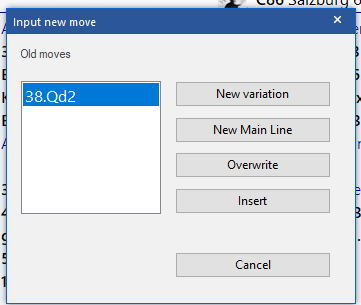


Larry Evans once aptly described one of the games in Bobby Fischer's collection of games as a magnificent adventure that took place in the notes. While the actual moves of the game were of course fascinating and of sporting interest, it was the astonishing and beautiful variations of what might have happened that arrested the reader's attention. It was the sheer skill of the two players that sidestepped all this fantasy, but that the former World Champion generously shared with the readers in the notes to the game.
It will come as no surprise to anyone who has used ChessBase (or Fritz) that the way to enter moves or new variations is simply to play a different move than the one played.

When you add a new move to an existing variation, a second branch, ChessBase will ask you if you want to start a new variation, create a new mainline, or overwrite the existing move.

But what does that mean? Starting yet a new variation is easy enough, while overwriting the existing move is also fairly clear. Create a new mainline is a ta trickier. It means that your new move will become the main variation while the move(s) that existed will become the variation.
Suppose you entered a series of lines, but want them in a different order of priority. For example, let's consider the variations below:

The mainline is 38. Qe3 and the note to it, shows what happens if White played 38. Qd2 instead. You realized however that 38. Qd2 is the better move and should be the mainline. What do you do? Erase the line and start over? Assuredly not! Just right-click on any move in the variation and select Promote variation.

Now the line with 38. Qd2 is the main line while 38. Qe3 is the note to it.

What if you want to simply get rid of the 38. Qe3 line altogether? Nothing could be easier. Click on any move in that line and right-click and choose Delete and then Delete variation, or alternately just use the shortcut Ctrl-Y.

In a chess book, and in real life, it is not uncommon to explain an idea as: "Black should play 11...Qb6 with the idea of ...Re8, ...Bf5, followed by ...Ne4" And while you can easily show an arrow for an idea, if you have a sequence of moves, a dump of arrows may be a bit confusing.

Instead, who not just show the idea on the board? In ChessBase you can do just that with the null-move option. Instead of playing a filler move, just go to Insert, then Enter Null Move.

You will be presented now with a move number and a skipped move. Now play the move of the sequence. You can do this as many times as you want. And this way can show the viewer exactly what you mean.

Click here to purchase ChessBase 16 in the shop
In the next tutorial, we will learn all about the the almighty colored arrows and squares, and diagrams.